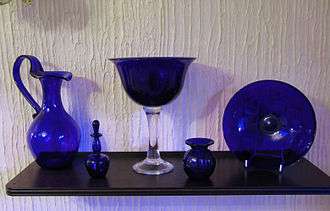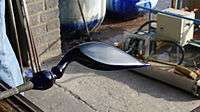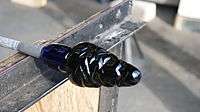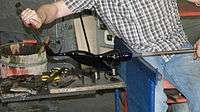Bristol blue glass

Bristol blue glass has been made in Bristol, England, since the 18th century, with a break between the 1920s and 1980s.
History
During the late 18th century Richard Champion, a Bristol merchant and potter, making porcelain, was working with a chemist, William Cookworthy.[1] Cookworthy began a search for good quality cobalt oxide to give the blue glaze decoration on the white porcelain and obtained exclusive import rights to all the cobalt oxide from the Royal Saxon Cobalt Works in Saxony.[2] It is uncertain when Bristol blue glass was first made but the quality and beauty of the glass swiftly gained popularity, with seventeen glass houses being set up in the city.[3]
Lazurus and Isaac Jacobs were the most famous makers of Bristol blue glass in the 1780s. Lazarus Jacobs was a Jewish immigrant to Bristol from Frankfurt am Main, Germany. In 1774, at the age of seventeen, Isaac joined his father's glass cutting firm at 108 Temple Street, Bristol, and launched Bristol Blue glass as a national brand, using the cobalt oxide Cookworthy imported. Isaac was responsible for the great growth of the company, and the expansion of its goods.[4] Their company held a royal warrant and made glass for the aristocrats of Europe.[5] Bristol’s glass makers were invited to demonstrate their skills at the Great Exhibition of 1851, opened by Queen Victoria and Prince Albert. At this period cranberry glass was made for the first time by adding 24 carat gold to lead crystal, giving the glass its ruby red tones.
Production ceased in about 1923.[6] Bristol James Adlington and Peter Sinclair, held their Hot Glass 1988 exhibition, at Hand Made Glass, Bristol. This exhibition led to a revival of Bristol's hand blown glass industry and the creation of a Company that has spawned the careers of many other studio Glassmakers in the South west.[7] Today, Bristol Blue Glass is produced by The Original Bristol Blue Glass Ltd in Brislington, established in 1988.
In the 1990s, John Harvey & Sons of Bristol began to sell Bristol Cream sherry in bottles made from Bristol blue.
Production
-

Bristol Blue Glass Heron Body
-

Bristol Blue Glass Heron Base
-

Bristol Blue Glass Heron. Beak being pulled into place
-

A stage in the manufacture of a Bristol Blue ship’s decanter.
Chemical composition
The glass contains cobalt oxide, which creates a deep yet bright blue, and 24% lead oxide (PbO).[8]
See also
References
- ↑ "Bristol Blue Glass". Business West. Retrieved 2007-09-01.
- ↑ Weeden, C. (December 1990). "William Cookworthy and Bristol blue glass". Glass Technology. 31: 256–65.
- ↑ "History of Bristol Blue Glass". Bristol Blue Glass USA. Archived from the original on 2007-06-09. Retrieved 2007-09-01.
- ↑ Madge Dresser, ‘Jacobs, Isaac (1757/8–1835)’, Oxford Dictionary of National Biography, Oxford University Press, 2004; online edn, Jan 2008 accessed 29 July 2016
- ↑ "Heritage". Bristol Blue Glass. Retrieved 2007-09-01.
- ↑ The History of Bristol Blue Glass Archived May 18, 2011, at the Wayback Machine.. Accessed 23 May 2011
- ↑ "About Bristol Blue Glass". Archived from the original on 2012-01-07. Retrieved 21 Dec 2011.
- ↑ Banks, M; N. Elphinstone; E.T. Hall (1963). "Bristol Blue Glass". Archaeometry. 6 (1): 26–30. doi:10.1111/j.1475-4754.1963.tb00575.x. Retrieved 2007-09-01.